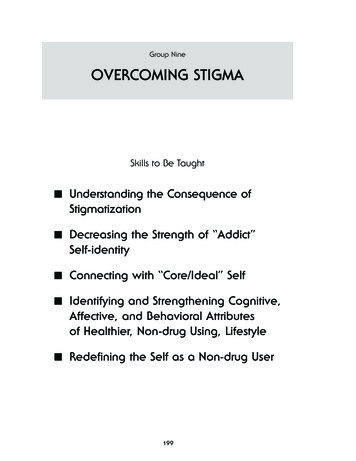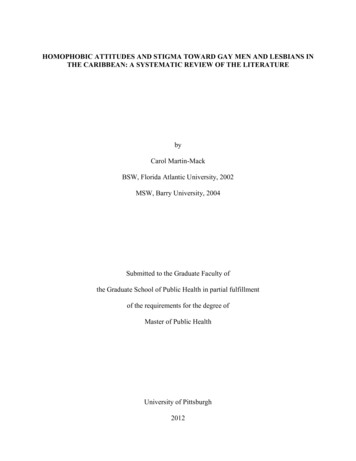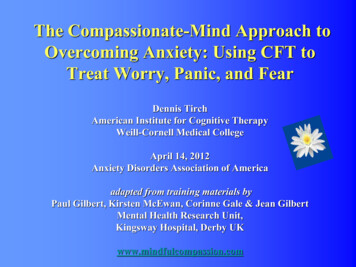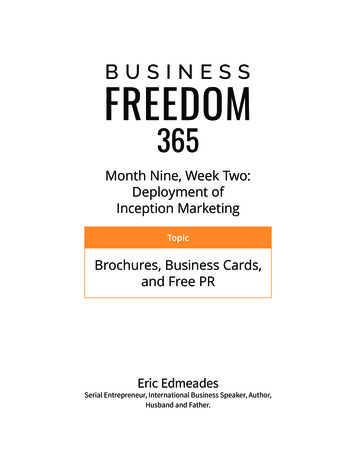
Transcription
Group NineOVERCOMING STIGMASkills to Be Taught Understanding the Consequence ofStigmatization Decreasing the Strength of “Addict”Self-identity Connecting with “Core/Ideal” Self Identifying and Strengthening Cognitive,Affective, and Behavioral Attributesof Healthier, Non-drug Using, Lifestyle Redefining the Self as a Non-drug User199
Overcoming StigmaCOUNSELOR TOOL BOXMulti-modal Presentation of Material:VerbalDidactic presentation of materialQuestioningGroup discussionVisualVisual presentation of major points using slidesGroup responses written on flipchart by counselorVideo recommended (not provided): “Eye of the Storm”Written/Pictorial handouts provided in Client n: Relaxation techniques“Mirror” practice exerciseGame: Preparing to act “as if”Post-group quizStress management/relaxation techniqueFlipchart and markersOverhead projector and slidesAudio tape player and relaxation tape3 5 index cardsClock/timerPens/pencilsPrizes“Loaner” Client WorkbooksHandouts:Group agendaGroup quizJoe and Ed Character Profile worksheetA Mirror into Your Ideal Self worksheet (double-sided)Certificate of Achievement (as warranted)Ensure that all material on quiz is covered wellduring group.Quiz material is indicated by QUIZ ITEM in the text.Instructions to counselors are provided in this typeface.200
Overcoming StigmaAGENDA(2-hour group: Adjust times based on beginning time)0:00Begin Group (5 mins)Introductions – Rules – Time keeper assignment0:05Introduction to Topic: Overcoming Stigma (5 mins)0:10Self-fulfilling Prophecy (5 mins)0:15Demonstration: Joe and Ed profiles (10 mins)0:25Effects of Stigmatization (5 mins)0:30Identifying Your “Core” Self (10 mins)0:40Practice Exercise: A Mirror into “Core” Self (10 mins)0:50Creating a Script for “Core” Self (5 mins)0:55BREAK (10 mins)1:05Review (5 mins)1:10Giving Your “Core” Self a Voice (10 mins)1:20Game: Preparing to Act “As if” (20 mins)1:40The Value of Self-redefinition (5 mins)1:45Quiz and Feedback (5 mins)1:50Relaxation Tape (10 mins)2:00End201
Overcoming StigmaBEGINNING OF EVERY GROUP (5 mins) Group members and counselors introduce themselves and welcomenew members Group rules are reviewedVisualShow Slide 9.1 Copy of agenda for today’s group is distributed to group members Ask for a volunteer to serve as time-keeper (to keep group on trackand on time) Announcement of any graduates from the group today Presentation of Certificate of Achievement to those who complete ingood standingVerbalCounselor provides introduction to today’s topic. (5 mins)Webster’s dictionary defines “stigma” as “a mark burned into the skin of acriminal or slave—a mark of infamy, disgrace, or reproach.” When individuals or groups are stigmatized, they are branded or labeled by society as dishonorable, reprehensible. Being stigmatized can influence how you thinkand feel about yourself and also how you behave. Everyone in this grouphas probably had personal experience with stigmatization. In our society,individuals suffering from addiction are stigmatized. The word “addict”brings to mind many negative images, and is generally associated withdefects in character, criminality, and immorality. This can be an extremely202
Overcoming Stigmaheavy burden to carry, and can substantially impede your progress alongyour journey of recovery.As the slide suggests, it’s as if you are walking around under a dark cloudwhile everyone else walks in the sunshine.VisualShow Slide 9.2After a while you may begin to internalize society’s stigmatizing labels—thatis, you come to believe that how other people perceive you must be an accurate representation of your “core” self. You may actually begin to think, feel,and behave just as others expect you to. QUIZ ITEM You may also experience shame and depression and engage in behaviors that place you and others at risk for jeopardizing your health, and even your life. The goal oftoday’s group is to weaken the impact of stigma—the negative labels thatare imposed upon you by others—and to strengthen your identification withyour “true” or “core” self that exists beneath all the labels.We will begin by considering various examples of self-fulfilling prophecy.Counselor presents material on self-fulfilling prophecy. (5 mins)A self-fulfilling prophecy is when you cause something to occur because youexpect it to occur. So if you internalize a label that is placed upon you byothers and begin to behave as the label predicts, your behavior would be anexample of a self-fulfilling prophecy.203Verbal/Discussion
Overcoming StigmaVisualShow Slide 9.3On the slide, you see an example. Mary has been labeled as “lazy” by herfamily. Perhaps Mary’s family placed high value on hard physical labor.Because Mary does not accomplish as much as other members of her family,she is considered lazy. But perhaps Mary is physically incapable of workingas hard as the other members of her family. Regardless of how the labelingoriginally occurred, because of this label and the attitude and behaviors ofthe family members towards Mary, Mary herself came to believe that sheshould be a hard worker, and that unless she was perceived by others as ahard worker, she was not worthwhile as a human being. However, her bestefforts were never good enough, and she began to doubt that she had theability to perform these tasks well. She therefore stopped trying, andbecame “a lazy person.” She fulfilled the prophecy.Let me give you another example:Counselor describes the “brown-eyes, blue-eyes” experiment, as follows:In 1970, a grade school teacher conducted a classroom experiment to teachyoung white children about racial prejudice. She told the children in herclass that blue-eyed children are inferior, lazy, and not very smart. She toldthem that blue-eyed children could not play with the brown-eyed childrenand had to drink from a different water fountain. She also told them thatbrown-eyed children are far superior to blue-eyed children. Brown-eyed children are smarter and work harder. The children then went about their dailylessons. In just a few hours, the work of the blue-eyed children had suffered; they took longer to do their assignments, they seemed unhappy, and204
Overcoming Stigmathey manifested some behavioral problems. Later when asked why theywere behaving this way, the children reported that there was no reason toeven try. The opposite occurred for the “superior” brown-eyed children—they felt good about themselves, performed well, and began to disparage theblue-eyed children. When the conditions were reversed later in the experiment, and the children were told that the blue-eyed children were superiorto the brown-eyed children, the children reversed their roles, again internalizing the labels given to them, and acting accordingly.Since this experiment in the 1970s, there have been numerous studies demonstrating the effect of labeling on the behavior of stigmatized individuals.Note to Counselor: We recommend showing a 10–15 minute segment froma video entitled “Eye of the Storm” which documents Jane Elliot’s 1970“brown-eyes, blue-eyes” experiment. It is not included with the materials forthis group because permission to duplicate the relevant segment was not provided by the copyright holder. However, the entire video can be purchasedfrom the distributor: Guidance Associates, 1-800-431-1242.Counselor leads group in a demonstration of stigmatization, as follows:(10 mins)Materials:Joe and Ed Character Profile m going to tell you a story of two men—Joe and Ed—who are applying forthe same job. Joe is a heroin addict now in methadone treatment whobecame infected with HIV by sharing needles. Ed was a thrill-seeker nowconfined to a wheelchair who was paralyzed in an accident while whitewaterrafting. Joe and Ed are equally qualified for the job. That’s all we knowabout Joe and Ed. The job requires not only the qualifications and workexperience that Joe and Ed both have, but also certain personality characteristics and qualities. The interviewers are given a “Character Profile” tocomplete for each applicant to help them with their hiring decision.I’m going to distribute the Character Profile worksheet to each of you andask you to predict how the interviewers would perceive the two candidates.In the first column on the worksheet is a list of characteristics. I’ll read205Experiential/Demonstration
Overcoming Stigmaeach characteristic aloud and you will circle either yes or no in the columnslabeled Joe and Ed to indicate which of the two job candidates are likely tobe thought to have that particular characteristic by the interviewers.Remember to answer as you predict the interviewers would describe Joe andEd.Counselor distributes Joe and Ed Character Profile Worksheets and thenslowly reads the list of characteristics. After reading each characteristic,Counselor says: Do you think the interviewers would attribute thischaracteristic to Joe or to Ed? Circle “yes” in either (not both) thecolumn labeled Joe or in the column labeled Ed. Counselor remindsgroup members that they should respond as they predict the interviewerswould opularLazyDependableDeserves to be sickVerbal/DiscussionJoe (the HIV-positivedrug addict)Ed (the es/noyes/noyes/noyes/noyes/noyes/noyes/noCounselor leads a discussion on effects of stigmatization. (5 mins)206
Overcoming StigmaYour profile worksheet probably looks like this:VisualShow Slide 9.4The slide shows that Joe—the HIV-infected heroin addict—was attributedwith all seven of the negative characteristics, in the absence of any personalinformation about the two men.QUESTIONS: Do you all agree that society would perceive these two men differently? Is it true that society feels that someone with HIV deserves to be sick? Is this especially true for an “addict,” or for anyone infected with HIV? Which man do you think would get the job? What other negative characteristics are associated with the word “Addict”?Counselor writes the additional negative attributes provided by groupmembers on the board under the heading “Addict.”Everyone in this room has to cope with this label and the characteristicsattributed to it every day, and some of you may even have come to believethat you really are what this label represents.207
Overcoming StigmaQUESTIONS: What effect does the label “Addict” have on you personally? Does this label really describe who you truly are deep down?Answer: You are not the labels placed on you by others. So, if these labels are not the real you, who is the real you? Let's go backto the day you were born.VerbalCounselor covers material on how to identify your “core” self. (10 mins)We are going back to the day you were born to see if we can answer twoquestions:1. Who were you when you were born? And,2. What kind of person did that newborn baby have the potential tobecome?VisualShow Slide 9.5As shown on the slide, when you think of a newborn baby, you probablythink— innocent, loving and lovable, playful, curious, trusting, vulnerable. you begin life as raw potential—awaiting to be fulfilled. you have no reason to suspect that there will be any obstacles to fulfillingyour highest potential.208
Overcoming StigmaEach of us is born this way. Then what happens? Each of us has a need— for unconditional love, and to be accepted and loved for our “core” self.Unfortunately, very soon we learn that love is often conditional—that meansthat we experience love and acceptance only when we behave the way otherswant us to behave. We learn that our “core” self is not always acceptable,and so other senses of self develop. In order to be loved and accepted by others, we internalize the “shoulds” imposed upon us by others, and our “ought”self is born. This is the person you feel you ought to be in order to receivethe love and acceptance of others. This “ought” self may develop into different senses of self at the center of the roles we play, such as student, friend,employee, parent. Each of these roles may be added to your “ought” sense ofself. Little by little, layer upon layer is placed on top of your “core” self sothat sometimes it is difficult to remember who you really are. You wonderwhatever became of that newborn that was so full of potential.VisualShow Slide 9.6Let’s look at Joe’s ought self. Joe was raised in a family that placed greatvalue on the external signs of success. Joe’s parents had experienced poverty in their own lives, and although they loved Joe, they worried that hewould not succeed in life. Joe learned from childhood that he should be rich,successful, powerful, handsome, physically fit, and popular. To be less thanperfect was to be a failure. As all children do, Joe tried very hard to internalize the qualities that were important to his parents.209
Overcoming StigmaQUESTION: What qualities would each of you include in your “ought” self?Counselor goes around the room and writes group members’ responseson the board in a column labeled “ought” self.VerbalIdeal Self.Let’s get back to Joe. Joe internalized the need to be perfect; however, hewas unable to fulfill his parents’ definition of perfection. As a child, Joetended towards shyness. He enjoyed quiet time alone drawing and painting,and showed artistic talent; he did not excel in school, and was not physicallystrong or particularly popular. He never felt comfortable when he attemptedto pursue the way of life valued by his parents. Consequently, by the timehe reached his teens he was experiencing low self-esteem, guilt and anxiety,and had began to perceive himself as a failure.Although Joe’s “ought” self included a number of positive qualities highlyvalued in our society, it did not include the attributes that Joe had thedesire or the potential to express in his life. Let’s take a look at the type ofperson Joe has the potential to be—Joe’s “ideal” self.VisualShow Slide 9.7As shown in the slide, Joe was born with the potential to experience innerpeace and to contribute to society using his artistic ability, and to raise andnurture children. Clearly, Joe’s “ought” self and his “ideal” self are in conflict.210
Overcoming StigmaQUESTION: What qualities would each of you include in your “ideal” selfthat is not included in your “ought” self?Counselor writes group members’ responses on the board in a columnlabeled “ideal” self.Back to Joe. When we left Joe, we were discussing the conflict between Joe’s“ought” self and his “ideal” self.VisualShow Slide 9.8Let’s look at what happened to Joe as a result of his battle between his different senses of self. As a teenager, he started socializing with other boyswho were not doing well in school. Together they used alcohol and marijuana, and their school work suffered even more. Joe dropped out of highschool with few prospects. One day, at a friend’s suggestion, Joe tried heroin. The anxiety he lived with was immediately reduced and he was able toenter that peaceful inner world he had always longed for. He was hooked.He could at last experience his ideal self. Of course, this feeling didn’t lastlong. Soon the drugs were controlling him, and that initial experience ofrelief from anxiety and the experience of absolute peace was no longerattainable.When you cannot live up to other people expectations for you, or when theseexpectations do not match your own goals and ideals, you have an imbalancebetween the “shoulds” and the “wants” in your life, and you cannot fulfillyour potential (your “core” self). This can lead to: QUIZ ITEM low self-esteem, depression, anxiety stress and stress-related illnesses substance abuse.211
Overcoming StigmaThis does not mean that other people are to blame for your addiction. Itdoes mean that recovery requires getting back in touch with your “core”self—the person you have the potential to be beneath all the labels imposedupon you. The first step is to identify the characteristics of your “ideal” selfand then create a mental image of yourself with these characteristics.QUIZ ITEM That’s what we’ll do now.Experiential/Practice“A mirror into your ‘ideal’ self” (10 mins)Materials:Mirror worksheetsPens/pencilsTherapeutic goals:Identify attributes of ideal or potential selfCounselor distributes the “mirror into your ideal self” worksheet to eachgroup member.Instructions:1. On your worksheet is a picture of a mirror. Imagine that you are lookingin that mirror at an image of yourself. Pretend that this is a magic mirror that allows you to see clearly your core self—your “ideal” or “potentialself”—the person that you really are beneath all the labels that othersplace on you.2. Then inside the mirror—describe your “core” or “ideal” self. Describe thekind of person you would truly like to be and that you believe you wouldhave had the potential to be if only given the opportunity and support.Inside the mirror write down the characteristics you would like to haveand the talents and gifts you were born with.Note: Ignore the areas outside the mirror labeled thoughts, feelings, andbehaviors. We will talk about these later.Counselors may provide a few examples of “ideal” self attributes, ifnecessary: e.g., healthy, peaceful, creative, loving, confident, generous,intelligent, good parent, spiritual, good friend, artist, athlete.212
Overcoming Stigma3. You will have 10 minutes to write a description of your “ideal” self insidethe mirror on your worksheet. Begin now.Counselor walks around the room to provide assistance to groupmembers as needed.Counselor provides instruction on creating a script for your “core” self.(5 mins)Now we will turn our attention to how you begin to get back in touch withyour “core” self—that person that you really are and are capable of becomingunderneath all the labels. Begin by imaging that you are an actor who hasbeen given an important role in a play. The character you are to portray issomeone with the same characteristics and qualities that you listed whenyou looked in the magic mirror into your “ideal” or “core” self. As an actor,the first thing you would do is research the role—you would identify howsuch a person would think, behave, and feel and then act as if you were aperson with these characteristics. QUIZ ITEMWhat you need to do is rather like reverse brainwashing. Brainwashing is atechnique used to indoctrinate an individual into a particular system ofbeliefs. We are all “brainwashed” to various degrees, although we probablywouldn’t call it brainwashing. Changing a person’s beliefs and even selfidentity can be accomplished by creating a context in which the individual isparticularly receptive, and then repeatedly exposing the individual to a setof beliefs. We all tend to be receptive during childhood and during adversity; however, we are also receptive when in a state of deep relaxation. Anexample of this is when someone is hypnotized they enter a relaxed state inwhich they are receptive to hypnotic suggestion.You can use these techniques in your daily life to get in touch with your“core” self. A positive, health-promoting form of brainwashing is the use ofself-affirmations. QUIZ ITEM Self-affirmations are positive statements yourepeat frequently to yourself for the purposes of changing your beliefs. Forexample, an actor preparing to play the role of a drug addict may repeatover and over to himself “I’ve got to have drugs to feel good” because this isa core belief of an addicted person. By strengthening this belief, the actorwould begin to feel more like an “addict.” He would also attempt to take onthe appearance of an “addict” and practice behaving as an “addict” wouldbehave, perhaps by exposing himself to drug-addicted individuals, drugneighborhoods, and
Group Nine OVERCOMING STIGMA Skills to Be Taught Understanding the Consequence of Stigmatization Decreasing the Strength of “Addict” Self-identity Connecting with “Core/Ideal” Self Identifying and Strengthe











